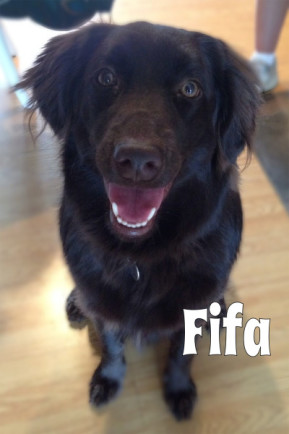The other day I was working with this sweet girl, Fifa, and one of her caregivers, Jennifer. We were going to go outside to begin teaching Fifa about walking on a loose leash, only, I quickly realized just the act of being near the front door sent her over her excited meter.
She could hardly wait to get out the door. How did I know? Her tail was wagging pretty quickly and she was jumping up at the storm door. In fact, she really could not focus on anything else except what was appearing through that clear window.
Calmness was something Fifa’s family wanted her to learn around doorways so I asked her to sit. And, she continued to jump. Was Fifa being bad or stubborn or obstinate?
 Not in my eyes. She was an adorable adolescent labradoodle who obviously has come to learn from her prior experience in situations like this that jumping on the doorway gets the door to open and the opportunity to experience everything that is great outside. And, had I opened the door at that moment, no doubt she would have been through it in a heartbeat.
Not in my eyes. She was an adorable adolescent labradoodle who obviously has come to learn from her prior experience in situations like this that jumping on the doorway gets the door to open and the opportunity to experience everything that is great outside. And, had I opened the door at that moment, no doubt she would have been through it in a heartbeat.
But her family would rather her show calm behaviors instead of bolting out the door.
The problem was – when she was in her overly excited state of mind, the opportunity to teach her anything was gone. If I had tried in that moment, more than likely I would have been setting us both up for failure.
When you are teaching any animal lessons in self control or anything else for that matter (and wanting to set them up for success), it is so important to begin where your student is capable of learning. That means carefully introducing distractions only at a level that will not set the animal over her threshold, and moving forward as the animal shows she can continue to focus.
With Fifa, setting her up for success only meant taking a few steps back. When she was about six feet from the door, she was able to sit when I asked her. And she was able to continuing sitting when asked. So we moved forward a couple steps and practiced again. She was still able to continue sitting. We followed this pattern up to the point where we got back to the storm door, where she originally could not focus at all. After enough repetitions of positive practice and setting her up for success, this time when I asked Fifa to sit – she sat! And she was able to remain seated as she saw the world on the other side of the storm door.
My take-a-way for you: Always ask yourself if your pet is not focusing, am I making this lesson too difficult? How can I better motivate my pet to want to listen?






